
Bio Final Exam Review
Protein structure and function
Proteins are made up of 4 different levels:
Primary- the sequence of amino acids linked together to form a polypeptide chain
Secondary- regular, recurring arrangements in space of adjacent amino acids
Tertiary: overall 3D structure of the polypeptide chain in space
Quaternary: the association of several protein chains or subunits into a closely packed unit
WHY?- -hydrophobic/hydrophilic so it forms that shape based on its polarity
-if you change one amino acid, the size and function changes
-if you replace one amino acid with the same one, nothing happens
Cell Division (cell cycle control, cancer, and mitosis)
Why do cells divide?
-repair or replacement:
after injury
growth
development from an embryo to adult
cancer (growth out of control) - caused by either too much cell division or not enough cell death
*Cell division is the only way single-celled organisms can reproduce*
In order to work, the functions of multi-celled organisms have to be tightly controlled
-communication → mediated by proteins
Cell cycle control:
-controlled by the CDK-cyclin system
CDK: cyclin-dependent kinase
cyclin: proteins that increase/ decrease during the cell cycle that has to build up enough during the cell cycle to bond CDK
The Cell Cycle + Mitosis

G1 (first gap phase):
newly divided cell enters this phase right after completing cell division (mitosis)
if the DNA is not damaged and enough resources are available, the cell will continue growing
growth signals will stimulate and it will move on to the next phase or it will die and go to the G0 phase where the cell “exits
S (synthesis):
the cell replicates its DNA
and the end of the phase, the cell has 2 sets of chromosomes
cell continues if there are no errors in the DNA
G2 (second gap phase):
cell continues to grow and prepares for cell division
all chromosomes have to be fully replicated and have no damage to continue on
M (Mitosis):
cell stops growing and divides into two daughter cells each with the same number of chromosomes

Mendelian Genetics
Law of Segregation: offspring acquire one hereditary factor from each parent
Law of Independent Assortment: different traits have an equal opportunity of occurring together
Law of Dominance: offspring with inherit the dominant trait, and can only inherit the recessive trait if they inherit both recessive factors
Dominant:
1 gene copy (1 allele) determines a trait
doesn’t physically “dominate”
the most prominent allele in the genes
they are not “better” than recessive alleles → mode of inheritance has nothing to do with whether an allele benefits an individual or not
Recessive:
2 allele copies determine a trait (lacks dominant allele)
“masked”
influences the phenotype only when there are 2 copies
Genotype: description of alleles that code for traits (PP, Pp, pp)
Phenotype: description of the physical or biochemical trait
Gametes: sperm or egg
Autosome: any chromosome that is not a sex chromosome

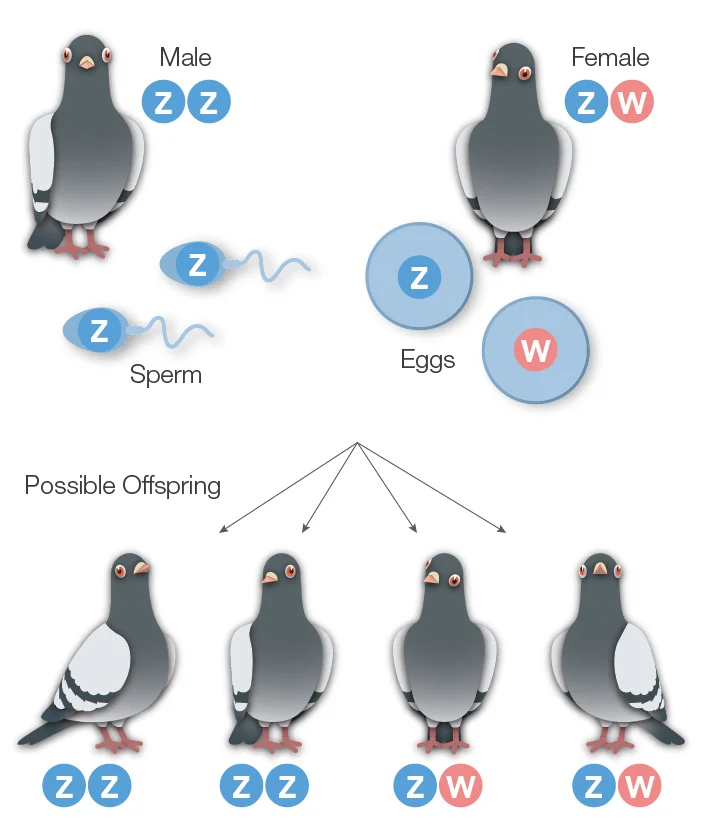
Molecular Genetics
Transcription: the process of copying a segment of DNA to RNA
Eukaryotic Transcription: takes place inside the Nucleus; proteins known as Transcriptional factors are needed
<strong>ProkaryoticTranscription:</strong>takes place in the Cytoplasm; no such proteins are needed.
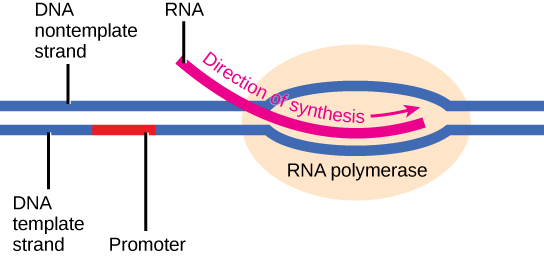
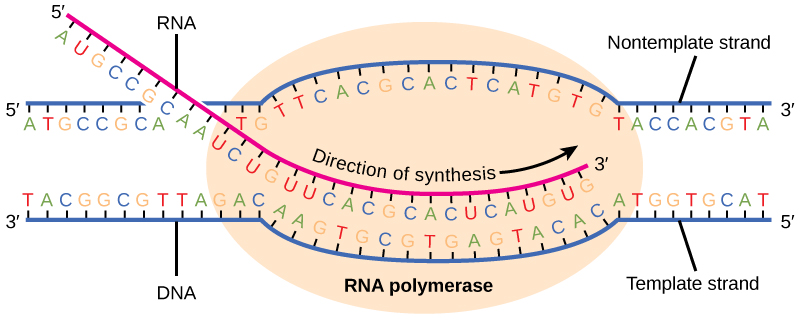

^^translation: ^^the process in which ribosomes in the cytoplasm synthesize proteins after the process of transcription
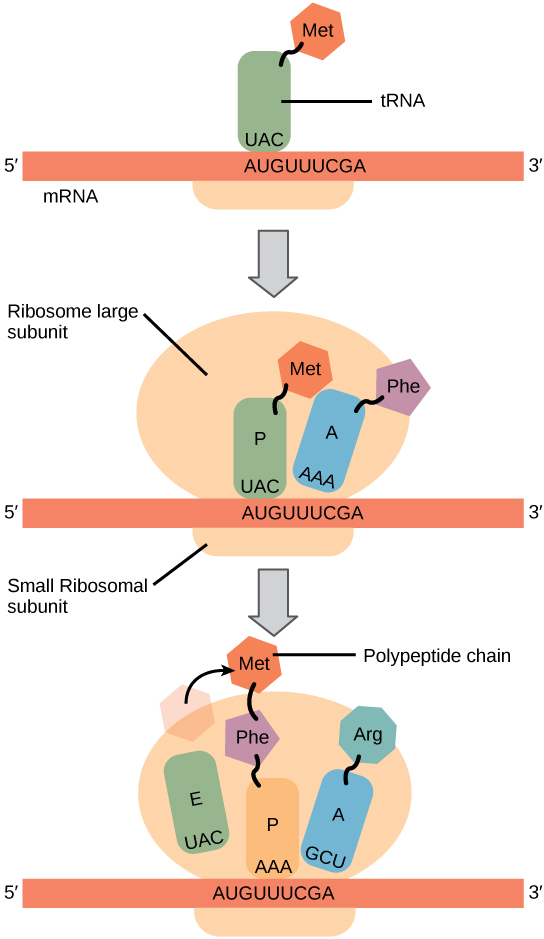
Genetic Code:

codon: the sequence of three consecutive nucleotides in a DNA or RNA molecule that codes for a specific amino acid. they are part of DNA or RNA molecules.
purpose: dictate the sequence of amino acids in a protein. molecules are added to a growing polypeptide by base pairing between the anticodon in its attached tRNA molecule and the next codon on the mRNA chain.
DNA:
double-stranded and contains thymine and deoxyribose
adenine pairs with thymine (A=T)
cytosine pairs with guanine (C=G)
replicates and stores genetic information; the blueprint for all genetic info
RNA:
RNA is single-stranded and contains uracil and ribose.
adenine pairs with uracil (A=U)
cytosine pairs with guanine (C=G)
converts genetic info contained within DNA to build proteins and then moves it to the ribosomal protein factories
DNA → RNA → Proteins
Lac Operon:
lac operon: a set of genes that are specific for the uptake and metabolism of lactose and is found in E. coli and other bacteria.
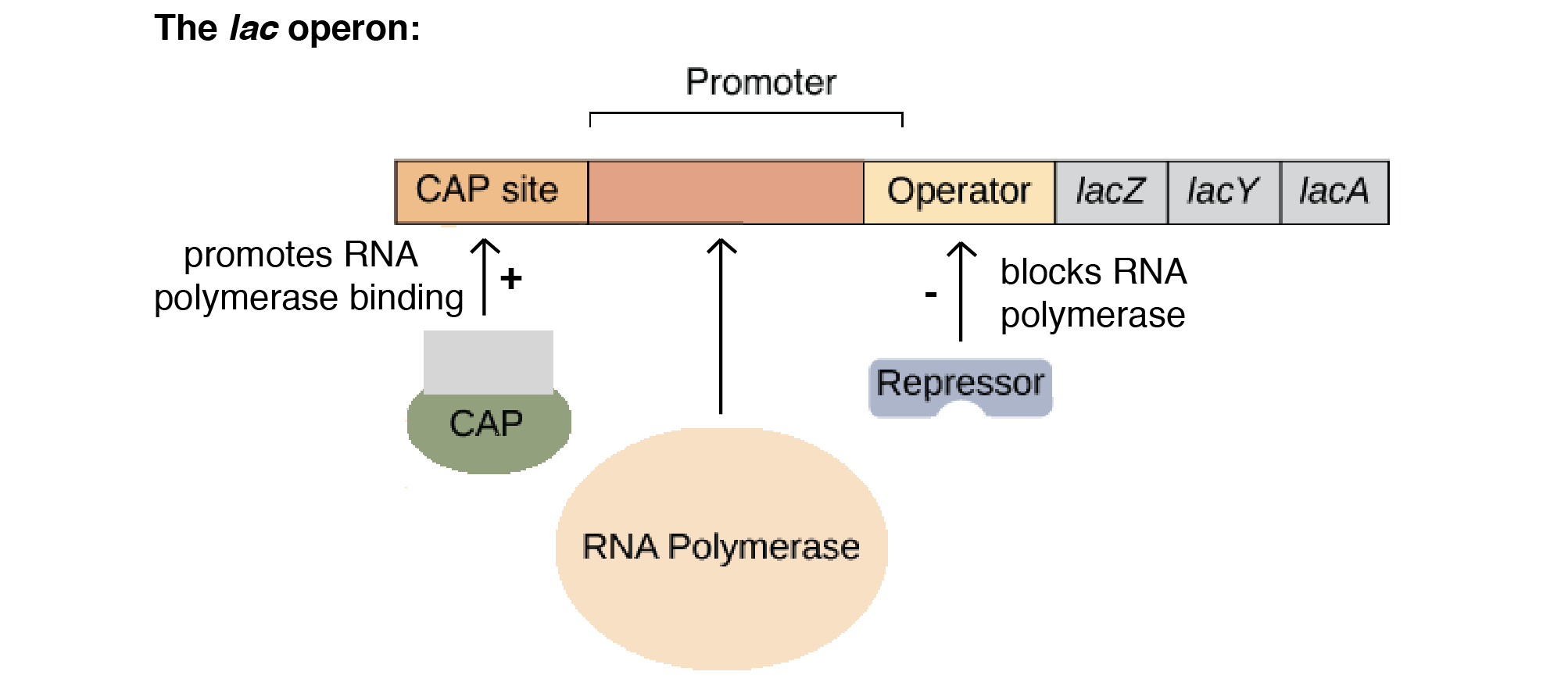
CAP: catabolic-operated protein activates transcription
RNA polymerase starts transcription at the promoter
Why is it inducible?
The lac operon is considered an inducible operon because it is usually turned off (repressed), but can be turned on in the presence of the inducer allolactose.
Mutations:
Most mutations in the operator, the binding site for the repressor, lead to a lower affinity for the repressor and hence less binding. Thus these mutations allow continued transcription (and thus expression) of the lac operon even in the absence of an inducer; this is referred to as constitutive expression.
Evolution
Four Principles of Natural Selection:
Variation:
differences in a population among individuals
must be genetic or hereditary → insures that variation will be passed down to future generations
Inheritance:
allows the variation to be passed down
Selection:
the mechanism for evolution
organisms that are more adapted to their environment are more likely to survive and pass on the genes that aided in their success
Time:
species evolve over time and is not an immediate change
Different ways a population can evolve:
mutations:
may affect the phenotype if the organism that gives it reduced fitness (lowering the likelihood of survival, resulting in fewer offspring)
natural selection:
a mechanism of evolution
Organisms that are more adapted to their environment are more likely to survive and pass on the genes that aided their success. This process causes species to change and diverge over time.
traits give an advantage over time and these traits become more common in the population
genetic drift:
causes random changes in allele frequencies when populations are small
genetic hitchhiking:
allele changes frequency not because it itself is under natural selection, but because it is near another gene that is undergoing selective sweep and that is on the same DNA chain
gene flow:
any movement of individuals and or the genetic material they carry from one population to another
Convergent v. Divergent
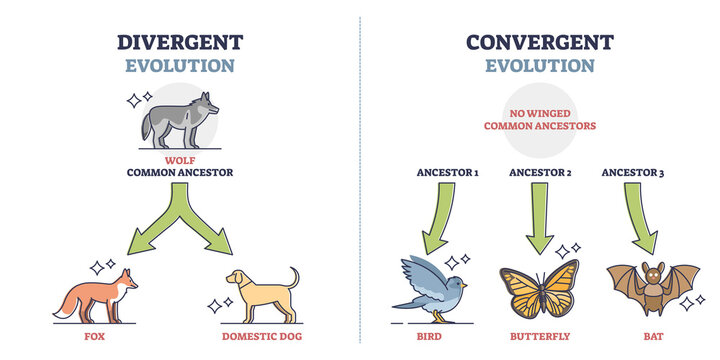
Stabilizing→ favors an average phenotype
ex: mice blend into their environment
Directional→ population undergoes an extreme after an environmental event
ex: peppered moths in an industrial area
Disruptive→ 2 or more phenotypes have an advantage for natural selection
ex: different lengths of tails are better for different things

Species→ are a group of potentially interbreeding (in a natural setting) organisms. Individuals are the same species if they can successfully reproduce
Speciation→ When a population can no longer reproduce, they have formed a new species; adaptations can make an inability to reproduce
adaptive radiation → Many adaptations evolve from a single point causing the species to radiate into several new ones
ex: Hawaiian islands provide the ideal context for this as it is surrounded by water on all sides leading to geographical isolation. The founder species of bird evolves into 6 other species with different characteristics
Short Answer
Proteins perform a wide variety of functions in cells. These functions depend upon proteins having a specific three-dimensional structure. Describe how proteins form into these complex shapes.
The different amino acids within a protein line up and form a polypeptide chain in the primary structure in order for the 3D structure to form later in the process.
Proteins have four levels of structure: primary, secondary, tertiary, and quaternary. The tertiary structure is the final folded shape that allows a protein to perform its function. Explain why the primary level of protein structure determines the final tertiary level.
The tertiary level is the 3D structure of the protein. Different amino acids within the polypeptide chain like to be near others and reject others based on polarity, if they are hydrophobic/hydrophilic, and their charge. The chain bends and folds in a way that meets all the requirements for the amino acids.
Give an example to help explain how evolution is both random and predictable
Evolution is based on how fit an organism is in its environment and only the most fit survive. If the organism cannot adapt to its environment or if it gets a detrimental mutation, it will not survive thus not passing those genes on. If the organism is thriving in that environment, it will reproduce and pass its genes on making that part of evolution predictable.
Explain why mammals have been naturally selected to enjoy sugar.
Mammals have evolved to like sugar because it is a source of energy and holds onto fat. When food was scarce, mammals benefited from eating sugar because it would hold onto their fat allowing them to survive when food was not readily available. Along the way, mammals who ate the sugar were the ones surviving in the wild, so they would pass the gene onto future generations.
Explain how antibiotic-resistant bacteria arise.
This can happen through mutations in the genes and selection. It develops a defense mechanism against the antibiotic and makes it no longer work.
7. Consider the following statement: the structure of DNA provides both a clue to how it is copied and a clue to how it can store information. Describe how the structure of DNA allows for copying, and describe how the structure of DNA codes for proteins.
DNA stores information in the nucleotides (A-T; C-G) and allows for the synthesis of a new strand of DNA. Each strand of DNA can act as a template strand for the synthesis of a new complementary strand. The order of the DNA sequence determines the amino acid for the protein it evolves.
8. Explain why individuals don’t evolve, but populations do – and conversely, why individuals are selected, but not populations
Individuals do not evolve because they do not change or evolve within their lifetime. Evolution takes place over time throughout generations and can shape a population, but does not happen to the individual.
9. Consider the statement: “Organisms will adapt the traits they need in order for the species to survive”. Explain why this is wrong.
This is wrong because evolution happens over the course of time to a population. If the individual is not born with a trait necessary to survive, the individual will die off and the individuals with the trait will survive. That trait will be passed down to future generations evolving the population.
10. If a little girl claimed that her brother was another species, why would she be mistaken? Explain what decides if two organisms constitute separate species.
A species is a group of similar organisms that are capable of exchanging genes and reproducing. In this case, the little girl would be wrong because her brother is human making him the same species as her.
Explain how organisms know that having certain traits are advantageous? Or do they…?
Organisms do not know that having certain traits is advantageous. Evolution is a natural process and traits will be passed down without their knowledge.
12. Fruits can be mighty yummy, it’s true. Many plants fill fruits with sugars as a tempting reward for animals who are willing to eat the fruit but leave the seeds to grow into new plants. Are plants foolish? Explain why, in this case, giving precious energy to another living thing is an evolutionary advantage.
Plants do this so there is a balance of energy. The plants expend energy on the future generation so they can survive longer and live a better life than they did.
13. The enzyme Catalase breaks down hydrogen peroxide, which is a harmful by-product of many chemical reactions. Explain the following: how the genetic code contains the information to make a protein; the process through which proteins are made from genes; how a protein can function as a catalyst (enzyme).
Genetic code allows for the coding of amino acids in proteins. Located in the nucleotides, the genetic code contains the information to make a protein. The sequence of the chains is what makes the different proteins. The process is called transcription in which proteins are made from genes. Enzymes are proteins that catalyze reactions for metabolism.
14. Organisms must control which proteins are active in a cell at any given time. Use an example to explain how organisms turn genes on and off.
Gene regulation proteins like Lac Operon repressors are normally off and are in an inducible state. This means they can be turned on in the presence of an inducer and in this case, it is lactose. When lactose is present, the gene is turned on.
15. List the cell cycle stages and explain how errors in cell cycle control at each stage can lead to disease states.
See notes above.
17. The phrase “survival of the fittest” is often associated with evolution, but what does “fittest” mean? Explain how a biologist would measure an organism’s fitness.
An organism’s fitness is based on how well-equipped or adapted they are in order to survive in a given environment. An example of this is a polar bear trying to survive in the jungle. They are not adapted to this environment and are used to much colder temperatures, so they are not fit for the environment.
18. Explain how organisms can read and express genes from entirely different organisms.
Genetic code is the same across different organisms. Recombinant DNA: putting a gene or part of a gene obtained from another organism into the genome of another organism.
19. The Modern Synthesis theory connects DNA & the genetic code to Mendelian Genetics and natural selection. Explain how genes can create variation, and how variation can lead to adaptation. Use the following vocabulary in your answer: gene, mutation, allele, phenotype.
Genes can become more diverse in a population through random mutations when before cell division, genetic material is rearranged. Different alleles arise (genetic variants) are passed through reproduction causing individuals in the population to express genotypes physically or express phenotypes. this creates diversity and desirable traits that help survival and leads to adaptations.
Bio Final Exam Review
Protein structure and function
Proteins are made up of 4 different levels:
Primary- the sequence of amino acids linked together to form a polypeptide chain
Secondary- regular, recurring arrangements in space of adjacent amino acids
Tertiary: overall 3D structure of the polypeptide chain in space
Quaternary: the association of several protein chains or subunits into a closely packed unit
WHY?- -hydrophobic/hydrophilic so it forms that shape based on its polarity
-if you change one amino acid, the size and function changes
-if you replace one amino acid with the same one, nothing happens
Cell Division (cell cycle control, cancer, and mitosis)
Why do cells divide?
-repair or replacement:
after injury
growth
development from an embryo to adult
cancer (growth out of control) - caused by either too much cell division or not enough cell death
*Cell division is the only way single-celled organisms can reproduce*
In order to work, the functions of multi-celled organisms have to be tightly controlled
-communication → mediated by proteins
Cell cycle control:
-controlled by the CDK-cyclin system
CDK: cyclin-dependent kinase
cyclin: proteins that increase/ decrease during the cell cycle that has to build up enough during the cell cycle to bond CDK
The Cell Cycle + Mitosis

G1 (first gap phase):
newly divided cell enters this phase right after completing cell division (mitosis)
if the DNA is not damaged and enough resources are available, the cell will continue growing
growth signals will stimulate and it will move on to the next phase or it will die and go to the G0 phase where the cell “exits
S (synthesis):
the cell replicates its DNA
and the end of the phase, the cell has 2 sets of chromosomes
cell continues if there are no errors in the DNA
G2 (second gap phase):
cell continues to grow and prepares for cell division
all chromosomes have to be fully replicated and have no damage to continue on
M (Mitosis):
cell stops growing and divides into two daughter cells each with the same number of chromosomes

Mendelian Genetics
Law of Segregation: offspring acquire one hereditary factor from each parent
Law of Independent Assortment: different traits have an equal opportunity of occurring together
Law of Dominance: offspring with inherit the dominant trait, and can only inherit the recessive trait if they inherit both recessive factors
Dominant:
1 gene copy (1 allele) determines a trait
doesn’t physically “dominate”
the most prominent allele in the genes
they are not “better” than recessive alleles → mode of inheritance has nothing to do with whether an allele benefits an individual or not
Recessive:
2 allele copies determine a trait (lacks dominant allele)
“masked”
influences the phenotype only when there are 2 copies
Genotype: description of alleles that code for traits (PP, Pp, pp)
Phenotype: description of the physical or biochemical trait
Gametes: sperm or egg
Autosome: any chromosome that is not a sex chromosome


Molecular Genetics
Transcription: the process of copying a segment of DNA to RNA
Eukaryotic Transcription: takes place inside the Nucleus; proteins known as Transcriptional factors are needed
<strong>ProkaryoticTranscription:</strong>takes place in the Cytoplasm; no such proteins are needed.



^^translation: ^^the process in which ribosomes in the cytoplasm synthesize proteins after the process of transcription

Genetic Code:

codon: the sequence of three consecutive nucleotides in a DNA or RNA molecule that codes for a specific amino acid. they are part of DNA or RNA molecules.
purpose: dictate the sequence of amino acids in a protein. molecules are added to a growing polypeptide by base pairing between the anticodon in its attached tRNA molecule and the next codon on the mRNA chain.
DNA:
double-stranded and contains thymine and deoxyribose
adenine pairs with thymine (A=T)
cytosine pairs with guanine (C=G)
replicates and stores genetic information; the blueprint for all genetic info
RNA:
RNA is single-stranded and contains uracil and ribose.
adenine pairs with uracil (A=U)
cytosine pairs with guanine (C=G)
converts genetic info contained within DNA to build proteins and then moves it to the ribosomal protein factories
DNA → RNA → Proteins
Lac Operon:
lac operon: a set of genes that are specific for the uptake and metabolism of lactose and is found in E. coli and other bacteria.

CAP: catabolic-operated protein activates transcription
RNA polymerase starts transcription at the promoter
Why is it inducible?
The lac operon is considered an inducible operon because it is usually turned off (repressed), but can be turned on in the presence of the inducer allolactose.
Mutations:
Most mutations in the operator, the binding site for the repressor, lead to a lower affinity for the repressor and hence less binding. Thus these mutations allow continued transcription (and thus expression) of the lac operon even in the absence of an inducer; this is referred to as constitutive expression.
Evolution
Four Principles of Natural Selection:
Variation:
differences in a population among individuals
must be genetic or hereditary → insures that variation will be passed down to future generations
Inheritance:
allows the variation to be passed down
Selection:
the mechanism for evolution
organisms that are more adapted to their environment are more likely to survive and pass on the genes that aided in their success
Time:
species evolve over time and is not an immediate change
Different ways a population can evolve:
mutations:
may affect the phenotype if the organism that gives it reduced fitness (lowering the likelihood of survival, resulting in fewer offspring)
natural selection:
a mechanism of evolution
Organisms that are more adapted to their environment are more likely to survive and pass on the genes that aided their success. This process causes species to change and diverge over time.
traits give an advantage over time and these traits become more common in the population
genetic drift:
causes random changes in allele frequencies when populations are small
genetic hitchhiking:
allele changes frequency not because it itself is under natural selection, but because it is near another gene that is undergoing selective sweep and that is on the same DNA chain
gene flow:
any movement of individuals and or the genetic material they carry from one population to another
Convergent v. Divergent

Stabilizing→ favors an average phenotype
ex: mice blend into their environment
Directional→ population undergoes an extreme after an environmental event
ex: peppered moths in an industrial area
Disruptive→ 2 or more phenotypes have an advantage for natural selection
ex: different lengths of tails are better for different things

Species→ are a group of potentially interbreeding (in a natural setting) organisms. Individuals are the same species if they can successfully reproduce
Speciation→ When a population can no longer reproduce, they have formed a new species; adaptations can make an inability to reproduce
adaptive radiation → Many adaptations evolve from a single point causing the species to radiate into several new ones
ex: Hawaiian islands provide the ideal context for this as it is surrounded by water on all sides leading to geographical isolation. The founder species of bird evolves into 6 other species with different characteristics
Short Answer
Proteins perform a wide variety of functions in cells. These functions depend upon proteins having a specific three-dimensional structure. Describe how proteins form into these complex shapes.
The different amino acids within a protein line up and form a polypeptide chain in the primary structure in order for the 3D structure to form later in the process.
Proteins have four levels of structure: primary, secondary, tertiary, and quaternary. The tertiary structure is the final folded shape that allows a protein to perform its function. Explain why the primary level of protein structure determines the final tertiary level.
The tertiary level is the 3D structure of the protein. Different amino acids within the polypeptide chain like to be near others and reject others based on polarity, if they are hydrophobic/hydrophilic, and their charge. The chain bends and folds in a way that meets all the requirements for the amino acids.
Give an example to help explain how evolution is both random and predictable
Evolution is based on how fit an organism is in its environment and only the most fit survive. If the organism cannot adapt to its environment or if it gets a detrimental mutation, it will not survive thus not passing those genes on. If the organism is thriving in that environment, it will reproduce and pass its genes on making that part of evolution predictable.
Explain why mammals have been naturally selected to enjoy sugar.
Mammals have evolved to like sugar because it is a source of energy and holds onto fat. When food was scarce, mammals benefited from eating sugar because it would hold onto their fat allowing them to survive when food was not readily available. Along the way, mammals who ate the sugar were the ones surviving in the wild, so they would pass the gene onto future generations.
Explain how antibiotic-resistant bacteria arise.
This can happen through mutations in the genes and selection. It develops a defense mechanism against the antibiotic and makes it no longer work.
7. Consider the following statement: the structure of DNA provides both a clue to how it is copied and a clue to how it can store information. Describe how the structure of DNA allows for copying, and describe how the structure of DNA codes for proteins.
DNA stores information in the nucleotides (A-T; C-G) and allows for the synthesis of a new strand of DNA. Each strand of DNA can act as a template strand for the synthesis of a new complementary strand. The order of the DNA sequence determines the amino acid for the protein it evolves.
8. Explain why individuals don’t evolve, but populations do – and conversely, why individuals are selected, but not populations
Individuals do not evolve because they do not change or evolve within their lifetime. Evolution takes place over time throughout generations and can shape a population, but does not happen to the individual.
9. Consider the statement: “Organisms will adapt the traits they need in order for the species to survive”. Explain why this is wrong.
This is wrong because evolution happens over the course of time to a population. If the individual is not born with a trait necessary to survive, the individual will die off and the individuals with the trait will survive. That trait will be passed down to future generations evolving the population.
10. If a little girl claimed that her brother was another species, why would she be mistaken? Explain what decides if two organisms constitute separate species.
A species is a group of similar organisms that are capable of exchanging genes and reproducing. In this case, the little girl would be wrong because her brother is human making him the same species as her.
Explain how organisms know that having certain traits are advantageous? Or do they…?
Organisms do not know that having certain traits is advantageous. Evolution is a natural process and traits will be passed down without their knowledge.
12. Fruits can be mighty yummy, it’s true. Many plants fill fruits with sugars as a tempting reward for animals who are willing to eat the fruit but leave the seeds to grow into new plants. Are plants foolish? Explain why, in this case, giving precious energy to another living thing is an evolutionary advantage.
Plants do this so there is a balance of energy. The plants expend energy on the future generation so they can survive longer and live a better life than they did.
13. The enzyme Catalase breaks down hydrogen peroxide, which is a harmful by-product of many chemical reactions. Explain the following: how the genetic code contains the information to make a protein; the process through which proteins are made from genes; how a protein can function as a catalyst (enzyme).
Genetic code allows for the coding of amino acids in proteins. Located in the nucleotides, the genetic code contains the information to make a protein. The sequence of the chains is what makes the different proteins. The process is called transcription in which proteins are made from genes. Enzymes are proteins that catalyze reactions for metabolism.
14. Organisms must control which proteins are active in a cell at any given time. Use an example to explain how organisms turn genes on and off.
Gene regulation proteins like Lac Operon repressors are normally off and are in an inducible state. This means they can be turned on in the presence of an inducer and in this case, it is lactose. When lactose is present, the gene is turned on.
15. List the cell cycle stages and explain how errors in cell cycle control at each stage can lead to disease states.
See notes above.
17. The phrase “survival of the fittest” is often associated with evolution, but what does “fittest” mean? Explain how a biologist would measure an organism’s fitness.
An organism’s fitness is based on how well-equipped or adapted they are in order to survive in a given environment. An example of this is a polar bear trying to survive in the jungle. They are not adapted to this environment and are used to much colder temperatures, so they are not fit for the environment.
18. Explain how organisms can read and express genes from entirely different organisms.
Genetic code is the same across different organisms. Recombinant DNA: putting a gene or part of a gene obtained from another organism into the genome of another organism.
19. The Modern Synthesis theory connects DNA & the genetic code to Mendelian Genetics and natural selection. Explain how genes can create variation, and how variation can lead to adaptation. Use the following vocabulary in your answer: gene, mutation, allele, phenotype.
Genes can become more diverse in a population through random mutations when before cell division, genetic material is rearranged. Different alleles arise (genetic variants) are passed through reproduction causing individuals in the population to express genotypes physically or express phenotypes. this creates diversity and desirable traits that help survival and leads to adaptations.
 Knowt
Knowt